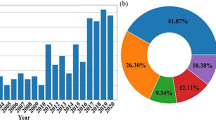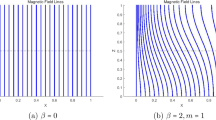Abstract
In this paper, a hybridizable discontinuous triangular spectral element method (HDTSEM) using tensorial nodal basis functions on unstructured meshes is proposed and analyzed. The elemental local basis is constructed from the one-to-one rectangle-to-triangle transform (Li et al., Lecture Notes in Computational Sciences and Engineering 76:237–246, 2011) and glued together under the hybridizable discontinuous Galerkin (HDG) framework. This offers much flexibility allowing for mismatch in nodal points across elements, substantial reduction in global degree of freedoms (DoFs) and excellent mesh adaptivity without sacrificing the high accuracy of a typical spectral element method (SEM). Here, optimal L2-error estimates are obtained on quasi-uniform unstructured meshes and ample numerical results are provided to validate the theoretical results.







Similar content being viewed by others
References
Adams, R.A., Fournier, J.: Sobolev Spaces. Academic Press, New York (1975)
Canuto, C., Hussaini, M.Y., Quarteroni, A., Zang, T.A.: Spectral Methods: Evolution to Complex Geometries and Applications to Fluid Dynamics. Scientific Computation Springer, Berlin (2007)
Chen, L., Shen, J., Xu, C.: A unstructured nodal spectral-element method for the Navier-Stokes equations. Commum. Comput. Phys. 12, 315–336 (2012)
Chen, Q., Babuška, I.: Approximate optimal points for polynomial interpolation of real functions in an interval and in a triangle. Comput. Methods Appl. Math. Eng. 128, 405–417 (1995)
Ciarlet, P.G.: The finite element method for elliptic problems SIAM (2002)
Cockburn, B., Gopalakrishnan, J., Lazarov, R.: Unified hybridization of discontinuous Galerkin, mixed, and continuous Galerkin methods for second order elliptic problems. SIAM J. Numer. Anal. 47, 1319–1365 (2009)
Cockburn, B., Qiu, W., Shi, K.: Conditions for superconvergence of HDG methods for second-order elliptic problems. Math. Comp. 81, 1327–1353 (2012)
Cockburn, B., Fu, G., Sayas, F.J.: Superconvergence by M-decompositions. Part i: General theory for HDG methods for diffusion. Math. Comp. 86, 1609–1641 (2017)
Deville, M.O., Fischer, P.F., Fischer, P.F., Mund, E., et al.: High-Order Methods for Incompressible Fluid Flow, vol. 9. Cambridge Monographs on Applied and Computational Mathematics, Cambridge University Press, Cambridge (2002)
Dolejší, V, Feistauer, M.: Discontinuous Galerkin method: Analysis and applications to compressible flow. Springer Series in Computational Mathematics, p. 48 (2015)
Dubiner, M.: Spectral methods on triangles and other domains. J. Sci. Comput. 6, 345–390 (1991)
Duffy, M.G.: Quadrature over a pyramid or cube of integrands with a singularity at a vertex. SIAM J. Numer. Anal. 19, 1260–1262 (1982)
Egger, H., Waluga, C.: Hp analysis of a hybrid DG method for stokes flow. SIAM J. Numer. Anal. 33, 687–721 (2013)
Georgoulis, E.H., Hall, E., Melenk, J.M.: On the suboptimality of the p-version interior penalty discontinuous Galerkiny method. J. Sci. Comput. 42, 54–67 (2010)
Haupt, L., Stiller, J., Nagel, W.E.: A fast spectral element solver combining static condensation and multigrid techniques. J. Comput. Phys. 255, 384–395 (2013)
Hesthaven, J.S.: From electrostatics to almost optimal nodal sets for polynomial interpolation in a simplex. SIAM J. Numer. Anal. 35, 655–676 (1998)
Hesthaven, J.S., Warburton, T.: Nodal discontinuous Galerkin methods: algorithms, analysis, and applications, vol. 54, Texts in Applied Mathematics Springer (2008)
Houston, P., Schwab, C., Süli, E.: Discontinuous hp-finite element methods for advection-diffusion-reaction problems. SIAM J. Numer. Anal. 39, 2133–2163 (2002)
Huismann, I., Stiller, J., Fröhlich, J.: Factorizing the factorization–a spectral-element solver for elliptic equations with linear operation count. J. Comput. Phys. 346, 437–448 (2017)
Karniadakis, G., Sherwin, S.: Spectral hp element methods for computational fluid dynamics, Numerical Mathematics and Scientific Computation, Oxford University Press New York (2005)
Kirby, R.M., Sherwin, S.J., Cockburn, B.: To CG or to HDG: a comparative study. J. Sci. Comput. 51, 183–212 (2012)
Koornwinder, T.: Two-variable analogues of the classical orthogonal polynomials, in Theory and application of special functions. Elsevier, pp 435–495 (1975)
Kopriva, D.A.: Implementing spectral methods for partial differential equations: Algorithms for scientists and engineers, Scientific Computation Springer (2009)
Li, H., Wang, L.-L.: A spectral method on tetrahedra using rational basis functions. Int. J. Numer. Anal. Model. 7, 330–355 (2010)
Li, J., Ma, H., Wang, L.-L., Wu, H.: Spectral element methods on hybrid triangular and quadrilateral meshes. Int. J. Numer. Anal. Model. 15, 111–133 (2018)
Li, Y., Wang, L.-L., Li, H., Ma, H.: A new spectral method on triangles. Lecture Notes in Computational Sciences and Engineering 76, 237–246 (2011)
Liu, W., Wang, L.-L., Wu, B.: Optimal error estimates for Legendre approximation of singular functions with limited regularity, arXiv:http://arxiv.org/abs/2006.00667 (2020)
Pasquetti, R., Rapetti, F.: Spectral element methods on unstructured meshes: which interpolation points? Numer. Algorithms 55, 349–366 (2010)
Patera, A.T.: A spectral element method for fluid dynamics: laminar flow in a channel expansion. J. Comput. Phys. 54, 468–488 (1984)
Pozrikidis, C.: Introduction to finite and spectral element methods using MATLAB Chapman & hall/CRC (2005)
Qiu, W., Shi, K.: An HDG method for convection diffusion equation. J. Sci. Comput. 66, 346–357 (2016)
Samson, M.D., Li, H., Wang, L.-L.: A new triangular spectral element method i: implementation and analysis on a triangle. Numer. Algorithms 64, 519–547 (2013)
Shan, W., Li, H.: The triangular spectral element method for Stokes eigenvalues. Math. Comp. 86, 2579–2611 (2017)
Shen, J., Wang, L.-L., Li, H.: A triangular spectral element method using fully tensorial rational basis functions. SIAM J. Numer. Anal. 47, 1619–1650 (2009)
Sherwin, S.J., Karniadakis, G.E.: A new triangular and tetrahedral basis for high-order (hp) finite element methods. Int. J. Numer. Meth. Eng. 38, 3775–3802 (1995)
Taylor, M.A., Wingate, B.A., Vincent, R.E.: An algorithm for computing Fekete points in the triangle. SIAM J. Numer. Anal. 38, 1707–1720 (2000)
Zhou, B., Wang, B., Wang, L.-L., Xie, Z.: A new triangular spectral element method II: Mixed formulation and hp-error estimates. Numer. Math. Theor. Meth. Appl. 12, 72–97 (2019)
Acknowledgements
The first and second authors received financial support provided by NSFC (grant 11771137, 12022104) and the Construct Program of the Key Discipline in Hunan Province. The research of the first author is partially supported by Hunan Provincial Innovation Foundation for Postgraduate (grant CX20190337). The research of the third author is supported by the Ministry of Education, Singapore, under its MOE AcRF Tier 2 Grants (MOE2018-T2-1-059 and MOE2017-T2-2-144). The fourth author is partially supported by NSFC (11771138).
Author information
Authors and Affiliations
Corresponding author
Ethics declarations
Conflict of interest
The authors declare no competing interests.
Additional information
Data availability
The datasets supporting the conclusions of this article are included within the article.
Publisher’s note
Springer Nature remains neutral with regard to jurisdictional claims in published maps and institutional affiliations.
Rights and permissions
About this article
Cite this article
Zhou, B., Wang, B., Wang, LL. et al. A hybridizable discontinuous triangular spectral element method on unstructured meshes and its hp-error estimates. Numer Algor 91, 1231–1260 (2022). https://doi.org/10.1007/s11075-022-01300-3
Received:
Accepted:
Published:
Issue Date:
DOI: https://doi.org/10.1007/s11075-022-01300-3
Keywords
- Spectral element method
- Hybridizable discontinuous Galerkin method
- Unstructured triangular mesh
- hp error analysis




